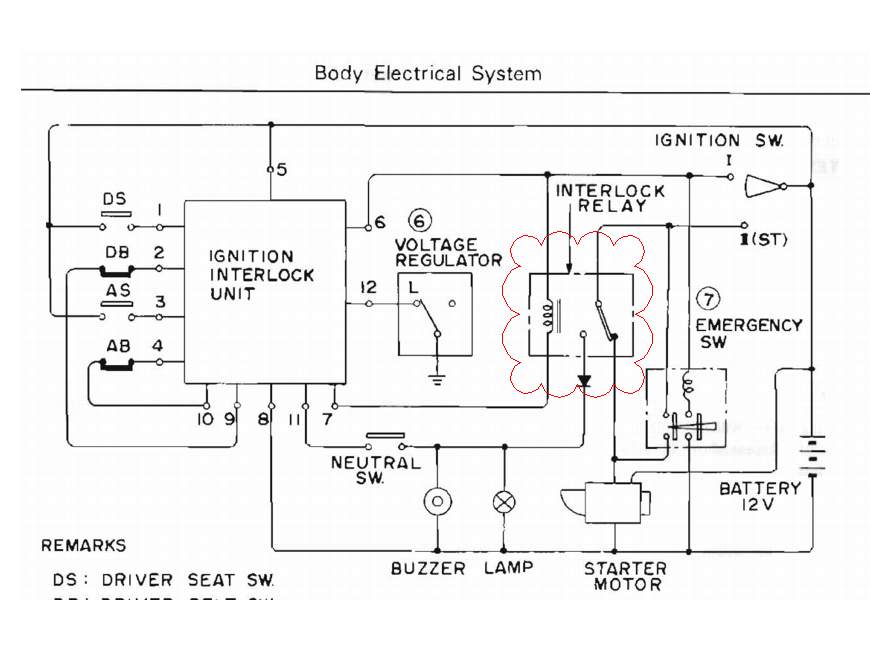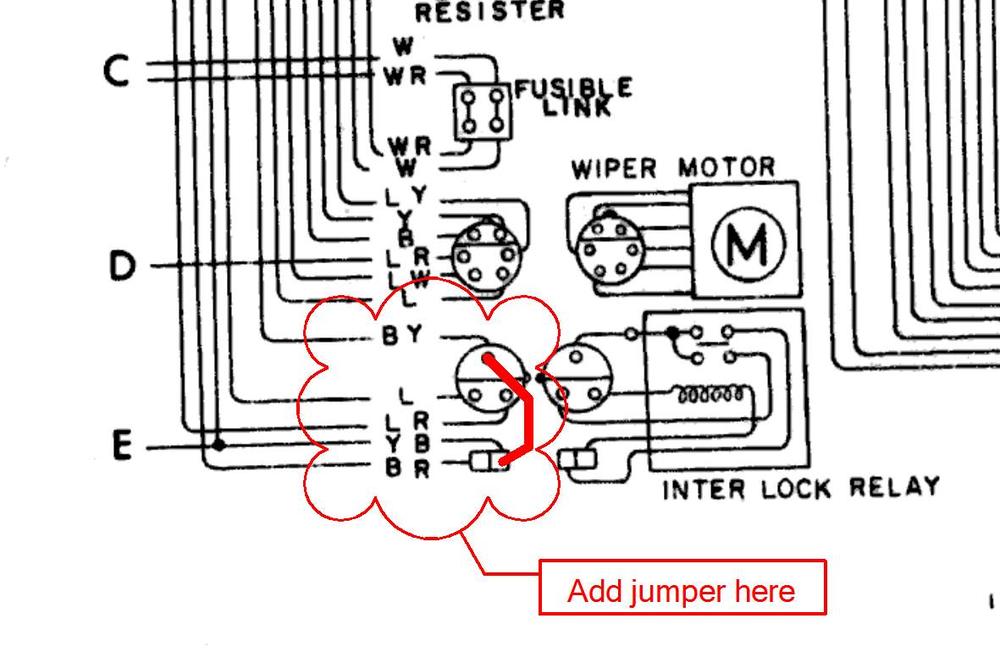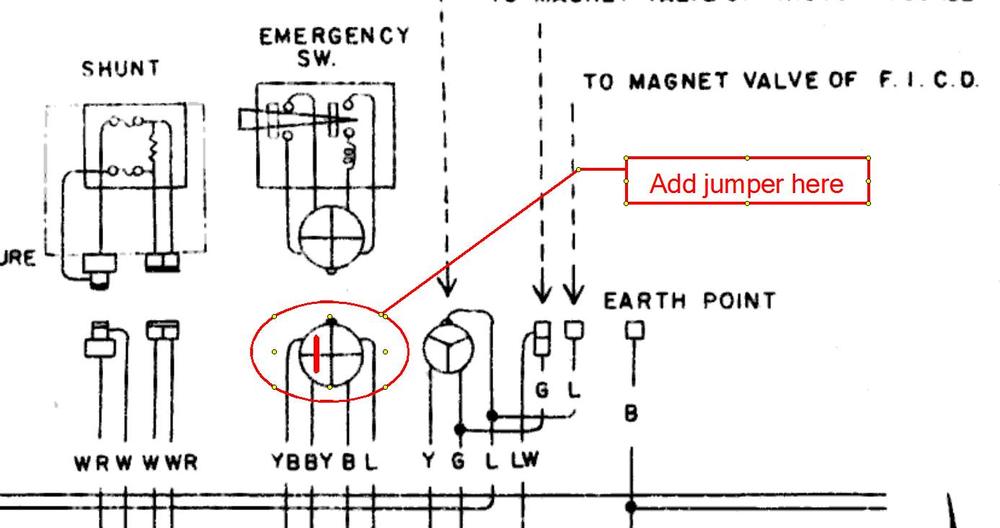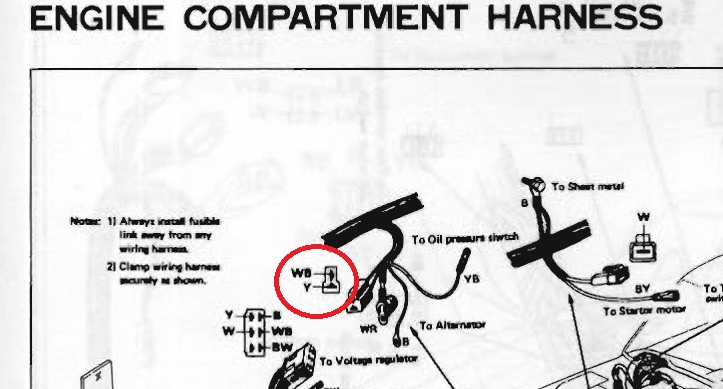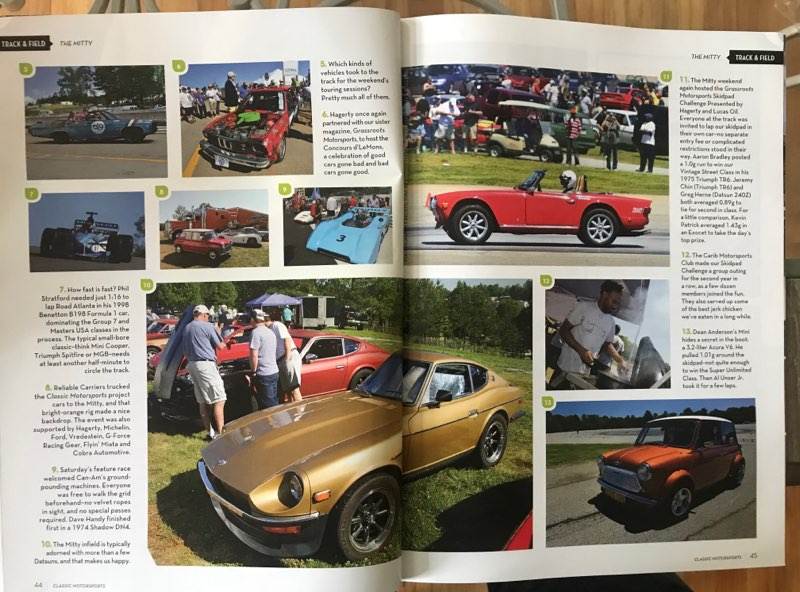Everything posted by SteveJ
-
260z interlock TSB
Any of the three solutions I provided should keep the Interlock Relay from interfering with starting. Good luck. Let us know what you do and how it worked.
-
Help with headlights
Are you sure you got the harness for the same year Z? There are minor differences.
-
260z interlock TSB
Have you looked at the logic of the switches in the BE section of the FSM? These workarounds focus on getting around the Interlock Relay shown highlighted in red in the first attachment. When the coil on this relay is energized, it keeps power away from the starter solenoid. Two solutions that I am sure that would work would require adding a jumper either at the Interlock Relay or at the Emergency Switch. The jumper would go between the Black/Yellow and Yellow/Black wires. There is one other solution that may work. If you disconnect the coil negative from ground on the Interlock Relay, that should defeat the seat belt interlock. From my reading of the wiring diagram it looks to be the Black/Red wire on the interlock unit. You want to disconnect this wire on the Interlock Unit side of the connector to prevent the chance of accidentally grounding the wire on the wire harness side.
-
Potentiometer
With seeing many threads about losing pressure because of the check valve, I have to wonder if anybody has tried a check valve like this: https://www.amazon.com/Airtex-CV8000-Check-Valve-E8120/dp/B001NKS48G
-
Engine crank no start
On the 78, the Fuel Pump Relay relies on the Fuel Pump Control Relay for power to the coil. It does not rely on the AFM. The connection to the flap on the AFM are labeled as "USELESS" in the factory diagram. The Fuel Pump Control Relay relies on two signals combined to energize the the Fuel Pump Relay. The ignition must be on, and there must be oil pressure. The fuel pump does not come on with the starter. You will not see any voltage at the fuel pump when trying to start the car. If you want to see if you have voltage at the fuel pump, you have to jumper the two Green/Blue wires at the Fuel Pump relay. (The Green/Blue wire next to the White/Black wire on the connector for the Fuel Pump Relay should have 12VDC to ground all of the time since it is connected to the fusible link.) I am pretty sure the FSM in the resources section on this site has the wiring diagram. Just click on the Resources tab. This is a better alternative for a wiring diagram:
-
Tires for my 1974 Datsun 260Z
I haven't used Toyos on my Z. What size wheels do you have?
-
2018 Grassroots Motorsports Mitty
I just got word today. John Morton, 4 time SCCA champion driver for BRE, will be the Grand Marshal.
- Quickest headlight upgrade?
-
Quickest headlight upgrade?
The best move is to get the headlight relay harness. Period. End. Light output is very dependent upon voltage. See https://www.dapperlighting.com/pages/wiring-harnesses-and-adapters Before I installed relays in my 73, I had 9 VDC at the headlight plug (car off), and it went to 12 VDC with the relays. That meant I was getting about twice as much light from the headlights (maybe more). If your alternator is struggling to keep up with the loads in the car, it's probably because of 1 of 2 things. 1. Your alternator is about to die. 2. You have too much non-stock crap wired into your car, like a huge stereo amp, etc.
-
Ignition Coil Wiring 1972 240Z
Well, you could see if someone jumpered out the connection on the back of the tach. If it's jumpered out, it was probably because it was bad.
-
Ignition Coil Wiring 1972 240Z
There are only a couple of wires involved. The Green/White (GW) wire comes from Start position on the key, goes through the tachometer, and comes out Black/White (BW). That BW wire goes to the positive of the coil. There is another BW wire. It comes off the ignition switch and goes out to the ballast resistor (and also branches off to the fuse box). On the other side of the ballast resistor is a GW wire that connects to the GW wire described above. Has the tach ever worked in the car since you owned it?
-
Clutch slave reservoir
That is probably the most prudent course of action. That way you only have to bleed the system once.
-
510 signal problems
I'm thinking that it might require some more in-depth diagnostics since you've had issues even after swapping out the switches.
-
510 signal problems
I'll try to make a drive up when the weather gets warmer.
-
Clutch slave reservoir
Look around the firewall where the Clutch Master comes through. Be sure to examine in the passenger compartment as well to see if the fluid came in through there.
-
Clutch slave reservoir
Did you see any signs of brake fluid on the ground or anywhere in the engine bay?
-
Fuel injection relay internal resistor value?
Like I said, the photo seemed to distort the colors. I thought the third color was brown.
-
Fuel injection relay internal resistor value?
The flash distorts from the color, but from what it appears to be to me, it looks like 270 Ohm 5%. https://www.digikey.com/en/resources/conversion-calculators/conversion-calculator-resistor-color-code-4-band By the way, here are some mnemonics for the color code. The one I remember is listed in the offensive area. I learned it from a former Navy electrician when I was 14. https://en.wikipedia.org/wiki/List_of_electronic_color_code_mnemonics
-
Lost the Parking Lights (with diagnostics)
I found the missing piece to the socket on my garage floor. The wire runs up through the button in the socket and is soldered in place. Somehow the solder joint weakened, and the wire came out. I removed the old solder from the button and ran the wire through it, soldering it back in place. If it holds for another 40 years, it will outlive me.
-
Lost the Parking Lights (with diagnostics)
I'm not sure. The socket was not in good condition when I pulled out the bulb. All I know is that I can leave that light dark without any problems.
-
Lost the Parking Lights (with diagnostics)
So did the wires on the 9 pin connector in the dash. I'm planning on de-rating the fuse on that circuit. I'd rather blow a fuse than burn up the wiring harness.
-
Lost the Parking Lights (with diagnostics)
The other night I was driving home in the dark when I noticed my the lighting for the gauges starting to fail. Soon, all I had left was the lighting on the speedometer, and it failed shortly after that. Fortunately I had a GPS unit running, so I could monitor my speed, but I was filled with dread thinking that my parking lights also went out. I checked the fuse and found it blown. I replaced it, but still no lights. I checked the connector in the steering column. It had suffered heat damage. (Note: The wires are not sized for a 20A fuse.) I replaced the connector (Thank you, Vintage Connections!) and tested. The ammeter I had on the battery was running over 20 A. I quickly shut off the switch. I looked for corrosion in the front side markers. They were fine. I returned to looking at the dash lights. I noticed the current was normal after removing the speedometer. I tested the wiring on the speedometer for a short. There were no shorts. I finally checked the GW & RL wires in the dash harness. The resistance was way too low. I unplugged all of the gauges, and no change. After looking at the FSM for other ideas, I unplugged the hazard switch. (The hazard switch in the 74 has a light.) The short went away. I pulled the switch out and found the cause. When the RL wire came loose from the light, it made contact with the other wire. When the speedometer was plugged in, the RL wire was then connected to ground, completing the path for the short. That only took 3 hours to find.
- Loose wire
-
September 2016 Classic Motorsports Magazine
I received a message from a friend today. He sent me this picture asking if it was my car. It got featured in coverage of The Mitty in 2016.
-
'72 or '73 wire harness to coil, need photo
I sent you a PM on the subject.





